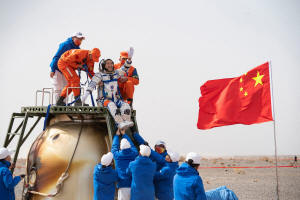|
The
astronauts landed nine hours after they left a key module of
China's first space station.
While in orbit, the Shenzhou-13 mission astronauts took manual
control in the Tianhe living quarters module for what state
media called a "docking experiment" with the Tianzhou-2 cargo
spacecraft.
Following their launch in October, the astronauts - Zhai Zhigang,
Ye Guangfu and a female crew member Wang Yaping - spent 183 days
in space, completing the fifth of 11 missions needed to finish
the space station by the end of the year.
Shenzhou-13 was the second of four planned crewed missions to
complete construction of the space station, which began last
April. Shenzhou-12 returned to Earth in September.
China's next two missions will be Tianzhou-4, a cargo
spacecraft, and the three-person Shenzhou-14 mission, Shao Limin,
deputy technology manager of Manned Spaceship System was quoted
by state media as saying.
Barred by the United States from participating in the
International Space Station (ISS) in orbit, China has spent the
past decade developing technologies to build its own space
station, the only one in the world other than the ISS.
China, which aims to become a space power by 2030, has
successfully launched probes to explore Mars and became the
first country to land a spacecraft on the far side of the Moon.
(Reporting by Liangping Gao in Beijing and Andrew Galbraith in
Shanghai; Editing by Raju Gopalakrishnan)
[© 2022 Thomson Reuters. All rights
reserved.]
This material may not be published,
broadcast, rewritten or redistributed.
Thompson Reuters is solely responsible for this content.

|
|




